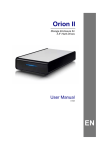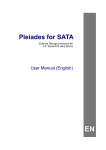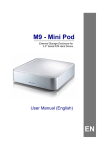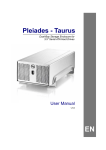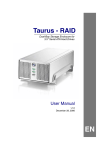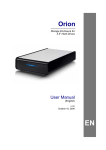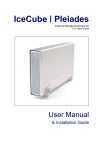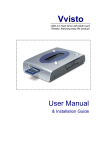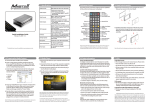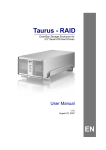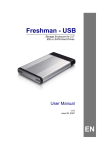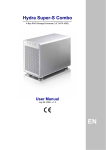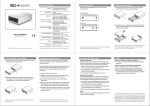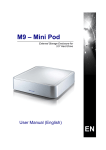Download Macpower & Tytech TVisto User manual
Transcript
DC-SATA Storage Enclosure for 2.5” SATA Hard Drives User Manual (English) v1.5 August 14, 2007 EN Table of Contents CHAPTER 1 - INTRODUCTION 1 CHAPTER 3 - SYSTEM SET UP 7 ICON KEY 1 CONNECTION TO YOUR COMPUTER 7 THE DC-SATA 1 POWER MANAGEMENT 7 AVAILABLE INTERFACES 1 INSTALLATION ON A PC 8 SYSTEM REQUIREMENTS 2 REMOVAL PROCEDURE 8 PC REQUIREMENTS 2 INSTALLATION ON A MACINTOSH 9 MAC REQUIREMENTS 2 REMOVAL PROCEDURE 9 PACKAGE CONTENTS 2 PARTITIONING & FORMATTING 10 LED INDICATOR 2 PC RUNNING WIN98SE OR WINME 10 PC RUNNING WINDOWS 2000, XP OR VISTA 11 CHAPTER 2 - HDD ASSEMBLY 3 MAC OS 12 DC-SATA USB 2.0 3 CHAPTER 4 - APPENDIX 13 DC-SATA 400+/800+/S2 5 TECHNICAL QUESTIONS 13 FAQ 13 ABOUT THIS MANUAL 13 DC-SATA User Guide Chapter 1 - Introduction Icon Key Throughout this manual you will see icons on the left margin that denote either Notes or Special Remarks as outlined below: General Notes and Tips Remarks for PC users and Microsoft Windows OS Remarks for Mac users and Apple Macintosh OS The DC-SATA Features mentioned in this manual may vary between different models. Sleek and elegant, the new DC-SATA is everything you would expect from Macpower. With an array of interfaces, this latest addition to the Daisy Cutter family is the perfect enclosure for 2.5" SATA drives. The Daisy Cutter just grew up. Product Dimensions: 12.5~13.4cm x 7.5cm x 1.4cm 4.92~5.28in x 2.95in x 0.55in Available Interfaces • • • • Firewire 800 & USB 2.0 (DC-SATA 800+) Firewire 400 & USB 2.0 (DC-SATA 400+) USB 2.0 High Speed (DC-SATA USB 2.0) eSATA & USB 2.0 (DC-SATA S2) MS-DOS, Microsoft, Windows 98/ME/2000/XP are trademarks of Microsoft Corporation. Apple Macintosh and Mac are trademarks of Apple Computer, Inc. All other third party brands and names are the property of their respective owners. Page 1 / Chapter 1 - Introduction DC-SATA User Guide System Requirements PC Requirements • • • • • Minimum Intel Pentium III CPU 500MHz, 128MB RAM USB 1.1 equipped PC; Windows 2000, XP, Vista USB 2.0 equipped PC; Windows 2000, XP, Vista 1394a equipped PC; Windows 98SE, 2000, XP, Vista 1394b or eSATA equipped PC; Windows 2000, XP, Vista Mac Requirements • • • • • Minimum Apple G4 processor, 128MB RAM USB 1.1 equipped Mac; Mac OS 10.2 or above USB 2.0 equipped Mac; Mac OS 10.2 or above 1394a equipped Mac; Mac OS 10.1.5 or above 1394b or eSATA equipped Mac; Mac OS 10.2 or above Package Contents Package Content may vary, depending on vendor & version. • DC-SATA enclosure • External power adapter; Input 100-240V, Output +5V/2A (please note: USB-only version is bus powered - therefore for this model the power adapter is optional) • Interface cables • Manual LED Indicator The DC-SATA USB 2.0 is using a double coloured LED. Green LED Red LED Status ON, power ON ON OFF Status ON, data access * ON ON Status OFF OFF OFF * Red LED flickers during data access. The DC-SATA 400+, 800+ and S2 are using a single blue LED. Blue LED Status ON, power ON ON Status ON, data access Flickering Status OFF OFF Page 2 / Chapter 1 - Introduction DC-SATA User Guide Chapter 2 - Hard Drive Assembly Your unit may come with a pre-installed hard drive. Before opening your enclosure, please read the warranty and any other notes from your vendor carefully, as this could void your warranty. DC-SATA USB 2.0 1. Remove the two screws from the rear panel and pull the panel with the bridge board gently out of the enclosure. Be careful not to damage any components when removing the rear panel. 2. Connect the bridge board to the SATA connector on the hard drive. Page 3 / Chapter 2 - HDD Assembly DC-SATA User Guide 3. Mount the bridge board to the hard drive with the two screws from the bottom as seen in following illustration. 4. Slide the bridge board and hard drive back into the enclosure. Be careful not to damage any components during the assembly. 5. Fasten the two screws for the back panel to finish the assembly. Page 4 / Chapter 2 - HDD Assembly DC-SATA User Guide DC-SATA 400+/800+/S2 1. Remove the two screws from the rear panel. 2. Remove the rear panel and pull the bridge board gently out of the enclosure. 3. Install the hard drive. Page 5 / Chapter 2 - HDD Assembly DC-SATA User Guide 4. Mount the hard drive with the four screws from the bottom as seen in following illustration. 5. Slide the bridge board and hard drive back into the enclosure. Be careful not to damage any components during the assembly. 6. Fasten the two screws for the back panel to finish the assembly. Page 6 / Chapter 2 - HDD Assembly DC-SATA User Guide Chapter 3 - System Set Up Connection to your Computer Here are a few tips on how to use your storage enclosure: Only one interface can be used at any given time. • Check the power cord and cables for visible damage before turning it on. If you buy a spare power adapter, make sure the output and polarity are identical with the power adapter supplied! • Do not cover the enclosure and be sure to leave enough room around it for the drive to cool down. • • • • Do not expose the product to water or humid conditions. Only one computer at the time can access the drive. Firewire can be daisy chained. All devices in a daisy chain have to be switched on to permit the hub/daisy chain to function. • Do not expose the product to water or humid conditions. • We recommend using the cables and adapter supplied with your product. Power Management Bus power is supported for devices with 6 and 9-pin Firewire connectors. Your port on the host side has to provide sufficient bus power to enable this function. If you use a 6-pin Firewire cable, make sure not to insert the connector the wrong way around, or you will damage the device! If you are using a 9 to 4-pin Firewire cable, bus power is not supported, so you will need to use an external power adapter. For USB, if the supplied bus power is limited or insufficient, an external power adapter or additional USB power cable is required. For optimal power consumption, we recommend using a short USB cable (20-30cm) and a drive with low power consumption. When connecting the drive using USB bus power, we strongly recommend using the USB onboard connector on your computer and not a USB front extension or hub. Page 7 / Chapter 3 - System Set Up DC-SATA User Guide Installation on a PC If the system doesn’t recognise the drive, turn on the power first, before connecting the interface cable or connect the device before booting your Operating System. If the drive has been pre-installed and setup already, you do not need to prepare anything else and can use it straight away. If you have installed the drive yourself and this is a brand new HDD, you will have to create a partition first and format the drive before it can be used. • • • • Turn on your Computer and start Windows Connect the Daisy Cutter and turn it on Let Windows search and install the driver automatically Open “My Computer” to see your external hard drive For factory new drives and more info about formatting, see following pages under “Partitioning & Formatting”. Removal Procedure For the safe removal of your drive and to assure that no data is lost, always follow the correct unplug procedure. Otherwise, an error message will appear. • Click on the taskbar icon for external hardware • Choose your external hard drive and confirm to remove it Page 8 / Chapter 3 - System Set Up DC-SATA User Guide Installation on a Macintosh If the system doesn’t recognise the drive, turn on the power first, before connecting the interface cable or connect the device before booting your Operating System. If the drive has been pre-installed and setup already, you do not need to prepare anything else and can use the unit straight away. If you have installed the drive yourself and this is a brand new HDD, you will have to create a partition first and format the drive before it will show up. • • • • Turn on your computer and start Mac OS Connect the Daisy Cutter and turn it on No driver installation required The external drive will mount and show up on your desktop For factory new drives and more info about formatting, see following pages under “Partitioning & Formatting”. Removal Procedure • Drag the external hard drive icon into the trash bin • Turn off your device For the safe removal of your drive and to assure that no data is lost, always follow the unplug procedure. Page 9 / Chapter 3 - System Set Up DC-SATA User Guide Partitioning & Formatting You can choose to create several partitions but be aware that if you want to change this at a later point, it’s required to format the drive again or use 3rd party software. Be aware that this will destroy any existing data on the drive, so make sure you have a backup! This step is usually only required the first time you install a factory new hard drive, if you change the format or want to erase all data on your drive. PC running Win98SE or WinME MS-DOS command “fdisk” (press Enter to confirm) • • • • • Type “fdisk” and press Enter Select ”Y” and press Enter Enter "5” to change the drive Select the drive you want to format Choose “1” and follow the onscreen instructions Win98SE and WinME do not recognise NTFS formatted drives, so if you want to use your drive on those platforms, we recommend you to use FAT32 instead. If you use this device to backup your data using a 3rd party software running MS-DOS, we recommend you to format the drive using FAT32. Page 10 / Chapter 3 - System Set Up DC-SATA User Guide PC running Windows 2000, XP or Vista For Windows 2000 and above, use the Disk Management Program to setup your drive. If the drive does not appear, make sure the drivers are installed properly and the power is turned on! • Right click on “My Computer” and choose “Manage” • Select “Disk Management” • Choose the drive you want to format and right click on it for further commands (Choose New Partition) • Follow the Partition Wizard If you are formatting the drive using the file system FAT32, the maximum size for a single file will be restricted to 4GB. Mac OS can not write to NTFS formatted drives. To use your device on both platforms, we recommend you to use FAT32. For Win2000 and above, we recommend formatting the drive using the NTFS file system. If you are using the FAT32 file system to format the drive on Win2000 and above, the biggest single partition you can create will be 32GB. To create larger partitions, you need to use the DOS command under Win98SE or WinME or change to NTFS format. Page 11 / Chapter 3 - System Set Up DC-SATA User Guide Mac OS For Mac OS X, use the Disk Utility to format and create partitions on your external disk. If the drive does not appear on the desktop, make sure there are no extension conflicts and the power is turned on! • Select “Disk Utility” in the utilities folder • Choose your external drive and format it according to your requirement You can choose to create several partitions but be aware that if you want to change this at a later point, it’s required to format the drive again. For Mac OS X, we recommend formatting the drive using the native Mac file system HFS+ also known as Mac OS Extended. If you are formatting the drive using the file system FAT32, the maximum size for a single file will be restricted to 4GB. If you want to use your drive on a PC running Microsoft Windows as well as on your Mac, we recommend formatting the drive on a PC. Choose FAT32 when formatting and do not change anything on the partition or format on your Mac, otherwise the PC might not be able to recognise the drive anymore. Page 12 / Chapter 3 - System Set Up DC-SATA User Guide Chapter 4 - Appendix Please read your warranty carefully, as this may vary between different vendors! Technical Questions For RMA and other questions, please contact your vendor or check out their online support area! FAQ Q: Can I use my device with USB bus power only? A: This will depend on the model, the hard drive, the USB cable and the computer. For some tips about optimizing the power consumption, please refer to Chapter 3. Q: What file system should I choose to format my drive? A: This will depend on how you want to use the drive but in general, here is what we recommend: • Windows 2000/XP/Vista Æ NTFS • Mac OS X Æ HFS+ (Mac OS Extended) • Win98/ME or to use it on both PC and Mac Æ FAT32 About this Manual This manual covers all interfaces and combinations for the Daisy Cutter (DC-SATA). Images and descriptions might therefore slightly vary between this manual and the actual product you have. © Copyright 2007 by Macpower & Tytech Technology Co., Ltd. all Rights Reserved The information contained in this manual is believed to be accurate and reliable. Macpower & Tytech Technology assumes no responsibility for any errors contained in this manual. Macpower & Tytech Technology reserves the right to make changes in the specifications and/or design of this product without prior notice. The diagrams contained in this manual may also not fully represent the product that you are using and are there for illustration purposes only. Macpower & Tytech Technology assumes no responsibility for any differences between the product mentioned in this manual and the product you may have. Page 13 / Chapter 4 - Appendix















